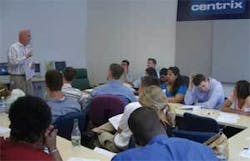From the ivory tower: Biodontics: Promoting acceptance of new products and technologies into the dental practice
By Edward F. Rossomando, DDS, PhD, MS Professor and Director, Center for Research and Education in Product Evaluation (CRETE) and Mathew Moura, BA Assistant for Educational and Special Programs, CRETE School of Dental Medicine University of Connecticut, Farmington, CT
Early adopters are critical to the success of the introduction of new products and technologies in any field and dentistry is no exception. Assuming the percentage of early adopters is at best 10 percent of the approximately 150,000 dentists in the U.S., the dental industry might expect the number of early adopters to be 15,000. However, these are only potential early adopters. Whether they do, in fact, adopt new products and technologies is a function of other variables, including age, gender, location, and type of practice. For example, it is unlikely that a 55-year-old dentist would be as eager to embrace a new technology as his or her 35-year-old counterpart.
Given that an innovative product’s success is determined more by its adoption rate than necessarily its usefulness, one would naturally assume that manufacturers and distributors would be most interested in identifying and increasing the number of early adopters. How might this be accomplished? One approach is to develop an educational program to encourage the early adoption of new technologies. An educational program requires a curriculum that introduces the principles of early adoption and experience in the use of these principles for decisions related to selecting and evaluating new technologies. Given that the number of dental graduates is about 4,200 per year and that 10 percent will be early adopters, we might expect to introduce 420 early adopters into the market each year. However, identifying which graduates will become early adopters is a difficult task.
Everett Rogers, in his study of the diffusion of innovations, lists more than 24 characteristics of early adopters. Many of these traits, such as education level and greater exposure to mass media and greater contact with change agents, can be seen in today’s dental students, whom I call the “Video Game Generation.” Today’s dental student visibly embodies the characteristics of an early adopter and innovator - tech-savvy, eager for any new gadget or device introduced to the market, and exposed to and skilled in wireless technologies and countless computer programs. It is obvious that today’s dental students are interested in new technologies and have the skills necessary to adopt these technologies at a faster rate than previous generations. A program designed to utilize the eagerness of dental students by exposing them to new technologies would promote the acceptance of new technologies and result in better oral health care for the American people.
Because identifying and enhancing the number of early adopters is critically important both to the dental industry and our patients, several dental manufacturers and distributors have endorsed the Biodontics Educational Program (BEP) at the University of Connecticut School of Dental Medicine. Supported in part by a grant from the National Institute of Dental and Craniofacial Research (NIDCR), the BEP curriculum was designed to enhance awareness of new products and technologies and to provide competency in product evaluation. The program was presented first in 2005 and again in 2006. Dental students from Connecticut, Marquette, Howard, and New York University were selected to participate in the 2006 program.
The 2006 BEP included talks by Dr. Arthur Ashman, founder of Bioplant Inc., Dr. Kenneth Kornman, a founder of Interleukin Genetics, Inc., and Dr. Jeffery Hillman, a founder of Oragenics. In addition, Dr. Foti Panagakos and Bette Hamilton of Colgate Palmolive, Inc., reviewed the processes Colgate uses to select innovations to bring products to market.
To explain the process of manufacturing, the BEP included tours of three Connecticut companies - Centrix, Inc., William Dragan, President; Pentron, Inc., James Mandell, President; and Ultimate NiTi Technologies, Michael Brault, General Manager. Patterson Dental and Benco Dental showed new and evolving products. Additionally, an overview of the dental market and principles of marketing were presented by Joe Sakaduski of Sakaduski Marketing Solutions, Inc. Under the guidance of Garret Ludwig of Diversified Design Technologies, Inc., the 2006 BEP Fellows also toured the dental offices of Drs. Egan, Hagopian, and Burns to see first-hand how, through creative dental office design, it is possible to integrate new technologies and products into a dental office as they emerge into the marketplace.
By increasing the number of early adopters, the BEP curriculum will graduate dentists more inclined to accept new products and technologies, and promote the transfer of new discoveries from the research laboratory to dental practice.
Editor’s Note: References available upon request.
Author’s Note: Dental companies or individuals interested in participating in the Biodontics Educational Program should contact Dr. Rossomando at [email protected].


